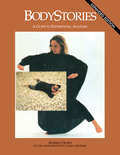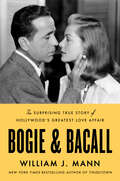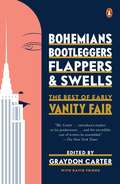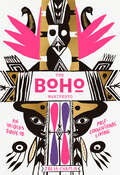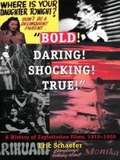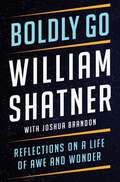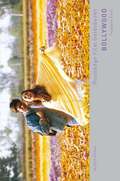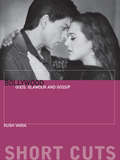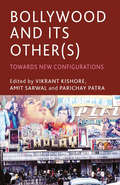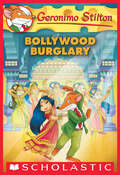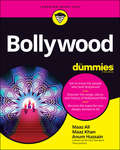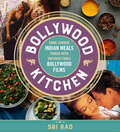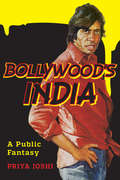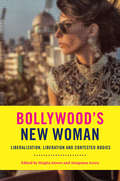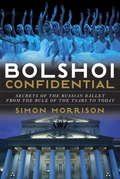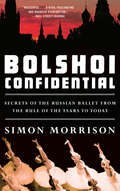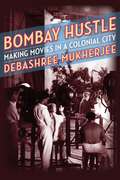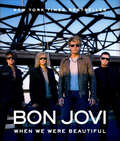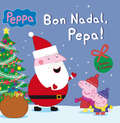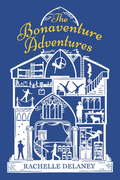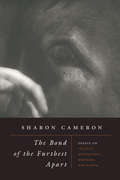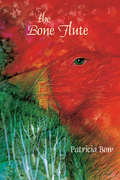- Table View
- List View
BodyStories: A Guide to Experiential Anatomy
by Andrea OlsenBodyStories is a book that engages the general reader as well as the serious student of anatomy. Thirty-one days of learning sessions heighten awareness about each bone and body system and provide self-guided studies. The book draws on Ms. Olsen's thirty years as a dancer and teacher of anatomy to show how our attitudes and approaches to our body affect us day to day. Amusing and insightful personal stories enliven the text and provide ways of working with the body for efficiency and for healing. BodyStories is used as a primary text in college dance departments, massage schools, and yoga training programs internationally.
Bogie & Bacall: The Surprising True Story of Hollywood's Greatest Love Affair
by William J. MannFrom the noted Hollywood biographer and author of The Contender comes this celebration of the great American love story—the romance between Lauren Bacall and Humphrey Bogart—capturing its complexity, contradictions, and challenges as never before.In Bogie & Bacall, William Mann offers a deep and comprehensive look at Lauren Bacall, Humphrey Bogart, and the unlikely love they shared. Mann details their early years—Bogart’s effete upbringing in New York City; Bacall’s rise as a model and actress. He paints a vivid portrait of their courtship and twelve-year marriage: the fights, the reconciliations, the children, the affairs, Bogie’s illness and Bacall’s steadfastness until his death. He offers a sympathetic yet clear-eyed portrait of Bacall’s life after Bogie, exploring her relationships with Frank Sinatra and Jason Robards, who would become her second husband, and the identity crisis she faced.Surpassing previous biographies, Mann digs deep into the celebrities’ personal lives and considers their relationship from surprising angles. Bacall was just nineteen when she started dating the thrice-married forty-five-year-old Bogart. How might that age gap have influenced their relationship? In addition to what she gained, what might Bacall have lost by marrying a Hollywood superstar more than twice her age? How did Bogart, a man of average looks, become one of the greatest movie stars of all time? Throughout, Mann explains the unparalleled successes of their individual careers as well as the extraordinary love between them and the legend that has endured.Filled with entertaining details and thoughtful insights based on newly available records and correspondence, and illustrated with 30-40 photographs, Bogie & Bacall offers a fresh look at this famous couple, their remarkable relationship, and their legacy.
Bohemians, Bootleggers, Flappers, and Swellss: The Best of Early Vanity Fair
by David Friend Graydon CarterOffering readers an inebriating swig from the great cocktail shaker of the Roaring Twenties--the Jazz Age, the age of Gatsby--Bohemians, Bootleggers, Flappers, and Swells showcases unforgettable writers in search of how to live well in a changing era. Vanity Fair editor Graydon Carter introduces these fabulous pieces written between 1913 and 1936, when the magazine published a Murderers' Row of the world's leading literary lights, including:F. Scott Fitzgerald on what a magazine should beClarence Darrow on equalitye. e. cummings on Calvin CoolidgeD. H. Lawrence on womenDjuna Barnes on James JoyceJohn Maynard Keynes on the collapse in money valueDorothy Parker on a host of topics, from why she hates actresses to why she hasn't marriedpo Marx, Carl Sandburg on Charlie Chaplin, Djuna Barnes on James Joyce, Douglas Fairbanks, Jr., on Joan Crawford, and Dorothy Parker on a host of topics ranging from why she hates actresses to why she hasn't married. These essays reflect the rich period of their creation while simultaneously addressing topics that would be recognizable in the magazine today, such as how women should navigate work and home life; our destructive fascination with the entertainment industry and with professional sports; the collapse of public faith in the financial industry; and, as Aldous Huxley asks herein, "What, Exactly, Is Modern?" Offering readers an inebriating swig from that great cocktail shaker of the Roaring Twenties, the Jazz Age, the age of Gatsby, Bohemians, Bootleggers, Flappers, and Swells showcases unforgettable writers in search of how to live well in a changing era.
The Boho Manifesto: An Insider's Guide to Postconventional Living
by Julia ChaplinThe bohemian disruption has arrived. Microdosing psychedelics has become the new business learning tool, spiritual ceremonies and ideas festivals are now coveted pastimes, and Burning Man is already a bigger cultural touchstone than Woodstock. Written by boho-from-birth Julia Chaplin, The Boho Manifesto is here to illuminate the revolution. This finely detailed and richly illustrated handbook is the essential guide to what lies beyond the experience of everyday conformity. You’ll learn how to quit the gym and go dancing instead and how to become a sex-positive tantric unicorn. And, should you be ready, there’s advice on how to leave your cubicle behind and embrace the life of a nomadic entrepreneur—or at least a nomad.
“Bold! Daring! Shocking! True!”: A History of Exploitation Films, 1919-1959
by Eric SchaeferUnashamed nudists, high-flying hopheads, brazen strippers, vicious vice lords, and high school girls who find themselves "in trouble" comprise the population of exploitation films. In the first full-scale history of these low-budget movies of decades past, Eric Schaefer reveals how this pioneering form of "trash film" purveyed the forbidden thrills of explicit sexual behavior, drug use, and vice that the mainstream movie industry could not show. Bold! Daring! Shocking! True! is a meticulously researched, interdisciplinary study that is informed by a wide range of sources--including both mainstream and industry newspapers and periodicals, archival accounts, personal interviews, and the films themselves. Schaefer begins by exploring the unique mode of production of exploitation movies, their distribution, and the outrageous exhibition practices that were rooted in the traditions of sideshows and carnivals. His close analysis of dozens of films, such as The Road to Ruin, Modern Motherhood, One Way Ticket to Hell, and The Wages of Sin demonstrates that these films were more than simply "bad" movies. By situating exploitation films in a historical context and organizing them according to the social problems they addressed, Schaefer shows how they evolved during a period of forty years and how, during that time, they shaped public policies and attitudes. Finally, he focuses on the changes in the postwar American film industry that led to the decline of the classical exploitation film and set the stage for the rise of "sexploitation" in the 1960s. Engagingly written, illustrated with rare photographs, posters, production stills, and ad slicks, and offering a full filmography, Bold! Daring! Shocking! True! reveals a forgotten side of film history and American culture. It will delight and inform those interested in film history, cultural studies, American studies and history, and the many fans of exploitation films.
Boldly Go: Reflections on a Life of Awe and Wonder
by William ShatnerThe beloved star of Star Trek, recent space traveler, and living legend William Shatner reflects on the interconnectivity of all things, our fragile bond with nature, and the joy that comes from exploration in this inspiring, revelatory, and exhilarating collection of essays.Long before Gene Roddenberry put him on a starship to explore the galaxy, long before he actually did venture to space, William Shatner was gripped by his own quest for knowledge and meaning. Though his eventful life has been nothing short of extraordinary, Shatner is still never so thrilled as when he experiences something that inspires him to simply say, &“Wow.&” Within these affecting, entertaining, and informative essays, he demonstrates that astonishing possibilities and true wonder are all around us. By revealing stories of his life—some delightful, others tragic—Shatner reflects on what he has learned along the way to his ninth decade and how important it is to apply the joy of exploration to our own lives. Insightful, irreverent, and with his signature wit and dramatic flair, Boldly Go is an unputdownable celebration of all that our miraculous universe holds for us.
Bollywood: A Guidebook to Popular Hindi Cinema (Routledge Film Guidebooks)
by Tejaswini Ganti'Bollywood' is the dominant global term to refer to the prolific Hindi language film industry in Bombay (renamed Mumbai in 1995). Characterised by music, dance routines, melodrama, lavish production values and an emphasis on stars and spectacle, Bollywood films have met with box-office success and enthusiastic audiences from India to West Africa to Russia, and throughout the English-speaking world. In Bollywood, anthropologist and film scholar Tejaswini Ganti provides a guide to the cultural, social and political significance of Hindi cinema, outlining the history and structure of the Bombay film industry, and the development of popular Hindi filmmaking since the 1930s. Providing information and commentary on the key players in Bollywood, including directors and stars, as well as material from current filmmakers themselves, the areas covered in Bollywood include: history of Indian cinema narrative style, main themes, and key genres of Hindi cinema significant films, directors and stars production and distribution of Bollywood films interviews with actors, directors and screenwriters.
Bollywood: Gods, Glamour, and Gossip (Short Cuts)
by Kush VariaWhile we have become familiar with the idea of "Bollywood" here in the West, we know little about the industry's films beyond a certain celebration of kitsch. Bollywood, the latest in Wallflower Press's Short Cuts introductory series, surveys this style of filmmaking from its origins in colonial times to the present, tracing its impact on both the Indian and global imagination. Chapters explore the history and workings of the industry, the narratives and aesthetics of its films, varieties within the genre, the cultural connotations of specific characters, its larger-than-life stars, and its hybrid and surprising fan cultures. Readings of popular and widely available films illustrate the importance of the cinema's conventions, which range from romantic clichés to a constant negotiation between tradition and modernity.
Bollywood
by Kush VariaWhile we have become familiar with the idea of "Bollywood" here in the West, we know little about the industry's films beyond a certain celebration of kitsch. Bollywood, the latest in Wallflower Press's Short Cuts introductory series, surveys this style of filmmaking from its origins in colonial times to the present, tracing its impact on both the Indian and global imagination. Chapters explore the history and workings of the industry, the narratives and aesthetics of its films, varieties within the genre, the cultural connotations of specific characters, its larger-than-life stars, and its hybrid and surprising fan cultures. Readings of popular and widely available films illustrate the importance of the cinema's conventions, which range from romantic clichés to a constant negotiation between tradition and modernity.
Bollywood and its Other(s): Towards New Configurations
by V. Kishore A. Sarwal P. PatraHow do we define the globalized cinema and media cultures of Bollywood in an age when it has become part of the cultural diplomacy of an emerging superpower? Bollywood and Its Other(s) explores the aesthetic-philosophical questions of the other through, for example, discussions on Indian diaspora's negotiations with national identity.
Bollywood and Its Other(s)
by Vikrant Kishore Amit Sarwal Parichay PatraHow do we define the globalized cinema and media cultures of Bollywood in an age when it has become part of the cultural diplomacy of an emerging superpower? Is it still an 'other' industry in a world dominated by Hollywood? Bollywood and Its Other(s) aims to compensate for the lack of scholarly literature on Indian film by opening up hitherto unexplored sites or sites that are in formation. It focuses on the aesthetic-philosophical questions of the other, Indian diaspora's negotiations with national identity, alternative reading strategies/research methods, marginal genres (sci-fi, horror), marginal characters (flaneuse, vamps), marginal gender (non-normative sexualities), marginal cinema (Hindi avant-garde), marginal language (Hinglish), and marginal regions (the Kashmir valley). It intends to address film scholars, South Asian studies researchers, cinephiles and lay readers alike.
Bollywood Burglary (Geronimo Stilton #65)
by Geronimo StiltonWhen you're with Geronimo Stilton, it's always a fabumouse adventure!My detective friend Hercule Poirat and I were headed to India. A Bollywood star we're friends with had received a valuable ruby and wanted us to help her protect it... which meant that I ended up acting in the movie she was filming! Rancid ricotta -- I'm a terrible actor! Even worse, just when we least expected it, the ruby was stolen. Could we find the thief?
Bollywood For Dummies
by Maaz Ali Maaz Khan Anum HussainTake the trip of a lifetime into the past and present of Bollywood Fascinated by the high energy, high emotion, high color, endless dance routines, and sheer scale of Bollywood—but afraid you'll never really know your Ghazals from your Qawwalis, or your Khans from your Kapoors? Well, in the immortal line from the Hindi-language blockbuster Sultan, "No one can defeat you unless you accept defeat yourself," and there's no need to be defeated at all when you can sit back with Bollywood For Dummies and immerse yourself in the glamorous whirl of one of the most exciting movie industries on Earth. Starting with the time-travel adventure of the book’s main feature—the history of the Hindi-speaking industry from people and events of early to mid 20th century Mumbai—you'll also journey in space, taking fascinating documentary side trips to get to know Tollywood’s Telegu-language cinema in southern India, as well as the growing influence of Lollywood across the border in Pakistan. Written by the cohosts of Desi Standard Time, a podcast that explores Bollywood and South Asian movies and media, you'll see how the unique cinema culture of Bollywood in particular has become a global phenomenon, reflecting the rise of India as an independent nation and presenting its long history—and it’s exciting and multifaceted present—in new, influential, and enduring forms. Whatever you paid the price of entry for: the popular Bollywood "Masala" movie style that emphasizes music, comedy, romance, and action; sensitive critiques of a fast-changing society by the Indian Social Realism movement; new forms of music from Indian disco to Sufi boogie; or a look at the lives and talents of the great acting dynasties—it's all here. And there'll still be plenty more plot twists beyond these to surprise and delight you. Get to know the people who built Bollywood Discover the main music and dance styles Explore and recognize Bollywood’s influence on Western cinema Go social and join up with the liveliest Bollywood fan communities You're right to be excited: for newbies a whole new world awaits, and for aficionados, there's always so much more to know. So, sit back with this book, grab some popcorn or a plate of samosas—or why not both—and prepare to begin an electric feast to sizzle all your senses.
Bollywood Kitchen: Home-Cooked Indian Meals Paired with Unforgettable Bollywood Films
by Sri Rao&“Rao gives new meaning to &‘dinner and a movie&’ by creating menus inspired by classic Indian films.&”—Houston Chronicle Indian cuisine and Indian cinema (known as Bollywood) share much in common—bold colors and flavors with plenty of drama. But to the uninitiated, they can seem dizzying. Let Sri Rao be your guide. As one of the only Americans working in Bollywood, Sri is an expert on Indian musical films, and as an avid cook, he&’s taken his mom&’s authentic, home-cooked recipes and adapted them for the modern, American kitchen. In this book you&’ll find dinner menus and brunch menus, menus for kids and menus for cocktail parties. Along with each healthy and easy-to-prepare meal, Sri has paired one of his favorite Bollywood movies. Every one of these films is a musical, packed with dazzling song-and-dance numbers that are the hallmark of Bollywood, beloved by millions of fans all over the world. Sri will introduce each film to you, explaining why you&’ll love it, and letting you in on some juicy morsels from behind the scenes. &“Rao has created more than a book of recipes. There is seldom a cookbook that voracious readers can flip through for story; this one feeds the eye and imagination. One can run their thumb and forefinger over technicolor pages featuring decadent film and food stills. The narrative also unearths the author: cheeky, perceptive, honest.&”—Edible Brooklyn &“Full of humor and insight, Bollywood Kitchen makes a great read, even if neither Bollywood nor cooking are your passions. A delightful read.&”—News India Times
Bollywood's India
by Priya JoshiIn a work of dazzling interpretive virtuosity, Priya Joshi returns popular Hindi cinema to the 1970s when the term "Bollywood" was deployed to dismiss an unruly cultural product marked by its social responsiveness. Joshi analyzes the social work of popular Hindi blockbusters that, she argues, capture and challenge the diffuse aspirations of the nation. The "India" fabricated in Bollywood's blockbusters revises and contests nation and the state, commenting on an India both imagined and real. Familiar depictions of crime and punishment, family and individuality, vigilante and community, have persisted in the cinema across half a century despite dramatic changes in the industry's production and distribution practices. Summoning the 1970s as an interpretive lens, Joshi deftly examines blockbusters from notably tumultuous moments when the idea of India was made, unmade, and remade. From the decline of the studios in the 1950s to the rise of the multi-starrer genre in the 1970s and the arrival of corporate capital and new media platforms in the 2000s, Bollywood's blockbusters nimbly engage the public fantasies of their heterogeneous audiences. Joshi's elegantly crafted argument incorporates fresh explorations of iconic films such as Awara (1951) and Deewaar (1975), as well as those less analyzed, such as Ab Dilli Dur Nahin (1957) and A Wednesday (2008).
Bollywood's India: A Public Fantasy
by Priya JoshiBollywood is India's most popular entertainment and one of its most powerful social forces. Its blockbusters contest ideas about state formation, capture the nation's dispersed anxieties, and fabricate public fantasies of what constitutes "India." Written by an award-winning scholar of popular culture and postcolonial modernity, Bollywood's India analyzes the role of the cinema's most popular blockbusters in making, unmaking, and remaking modern India. With dazzling interpretive virtuosity, Priya Joshi provides an interdisciplinary account of popular cinema as a space that filters politics and modernity for its viewers. Themes such as crime and punishment, family and individuality, vigilante and community capture the diffuse aspirations of an evolving nation. Summoning India's tumultuous 1970s as an interpretive lens, Joshi reveals the cinema's social work across decades that saw the decline of studios, the rise of the multi-starrer genre, and the arrival of corporate capital and new media platforms. In elegantly crafted studies of iconic and less familiar films, including Awara (1951), Ab Dilli Dur Nahin (1957), Deewaar (1975), Sholay (1975), Dil Se (1998), A Wednesday (2008), and 3 Idiots (2009), Joshi powerfully conveys the pleasures and politics of Bollywood blockbusters.
Bollywood’s New Woman: Liberalization, Liberation, and Contested Bodies
by Megha Anwer and Anupama AroraBollywood’s New Woman examines Bollywood’s construction and presentation of the Indian Woman since the 1990s. The groundbreaking collection illuminates the contexts and contours of this contemporary figure that has been identified in sociological and historical discourses as the “New Woman.” On the one hand, this figure is a variant of the fin de siècle phenomenon of the “New Woman” in the United Kingdom and the United States. In the Indian context, the New Woman is a distinct articulation resulting from the nation’s tryst with neoliberal reform, consolidation of the middle class, and the ascendency of aggressive Hindu Right politics.
Bolshoi Confidential: Secrets of the Russian Ballet from the Rule of the Tsars to Today
by Simon MorrisonIn this enthralling, definitive new history of the Bolshoi Ballet, sensational performances onstage compete with political machinations backstage.On January 17, 2013, a hooded assailant hurled acid into the face of the artistic director of the Bolshoi Ballet, making international headlines. A lead soloist, enraged by institutional power struggles, later confessed to masterminding the crime. The scandal, though shocking, is not an anomaly in the turbulent and tormented yet magnificent history of the Bolshoi. Renowned music historian Simon Morrison reveals the ballet as a crucible of art and politics, beginning with the disreputable inception of the theatre in 1776 and proceeding through the era of imperial rule, the chaos of revolution, the oppressive Soviet years, and the recent $680 million renovation project. Drawing on exclusive archival research, Morrison creates a richly detailed tableau of the centuries-long war between world-class art and life-threatening politics that has defined this storied institution. As Morrison makes clear, as Russia goes, so goes the Bolshoi Ballet.
Bolshoi Confidential: Secrets of the Russian Ballet from the Rule of the Tsars to Today
by Simon MorrisonAn enthralling, definitive new history of the Bolshoi Ballet, where visionary performances onstage compete with political machinations backstage. On a freezing night in January 2013, a hooded assailant hurled acid in the face of the artistic director of the Bolshoi Ballet. The crime, organized by a lead soloist, dragged one of Russia’s most illustrious institutions into scandal. The Bolshoi Theater had been a crown jewel during the reign of the tsars and an emblem of Soviet power throughout the twentieth century. Under Putin in the twenty-first century, it has been called on to preserve a priceless artistic legacy and mirror Russia’s neo-imperial ambitions. The attack and its torrid aftermath underscored the importance of the Bolshoi to the art of ballet, to Russia, and to the world. The acid attack resonated far beyond the world of ballet, both into Russia’s political infrastructure and, as renowned musicologist Simon Morrison shows in his tour-de-force account, the very core of the Bolshoi’s unparalleled history. With exclusive access to state archives and private sources, Morrison sweeps us through the history of the storied ballet, describing the careers of those onstage as well as off, tracing the political ties that bind the institution to the varying Russian regimes, and detailing the birth of some of the best-loved ballets in the repertoire. From its disreputable beginnings in 1776 at the hand of a Faustian charlatan, the Bolshoi became a point of pride for the tsarist empire after the defeat of Napoleon in 1812. After the revolution, Moscow was transformed from a merchant town to a global capital, its theater becoming a key site of power. Meetings of the Communist Party were hosted at the Bolshoi, and the Soviet Union was signed into existence on its stage. During the Soviet years, artists struggled with corrosive censorship, while ballet joined chess tournaments and space exploration as points of national pride and Cold War contest. Recently, a $680 million restoration has restored the Bolshoi to its former glory, even as prized talent has departed. As Morrison reveals in lush and insightful prose, the theater has been bombed, rigged with explosives, and reinforced with cement. Its dancers have suffered unimaginable physical torment to climb the ranks, sometimes for so little money that they kept cows at home whose milk they could sell for food. But the Bolshoi has transcended its own fraught history, surviving 250 years of artistic and political upheaval to define not only Russian culture but also ballet itself. In this sweeping, definitive account, Morrison demonstrates once and for all that, as Russia goes, so goes the Bolshoi Ballet.
Bombay Hustle: Making Movies in a Colonial City (Film and Culture Series)
by Debashree MukherjeeFrom starry-eyed fans with dreams of fame to cotton entrepreneurs turned movie moguls, the Bombay film industry has historically energized a range of practices and practitioners, playing a crucial and compelling role in the life of modern India. Bombay Hustle presents an ambitious history of Indian cinema as a history of material practice, bringing new insights to studies of media, modernity, and the late colonial city.Drawing on original archival research and an innovative transdisciplinary approach, Debashree Mukherjee offers a panoramic portrait of the consolidation of the Bombay film industry during the talkie transition of the 1920s–1940s. In the decades leading up to independence in 1947, Bombay became synonymous with marketplace thrills, industrial strikes, and modernist experimentation. Its burgeoning film industry embodied Bombay’s spirit of “hustle,” gathering together and spewing out the many different energies and emotions that characterized the city. Bombay Hustle examines diverse sites of film production—finance, pre-production paperwork, casting, screenwriting, acting, stunts—to show how speculative excitement jostled against desires for scientific management in an industry premised on the struggle between contingency and control. Mukherjee develops the concept of a “cine-ecology” in order to examine the bodies, technologies, and environments that collectively shaped the production and circulation of cinematic meaning in this time. The book thus brings into view a range of marginalized film workers, their labor and experiences; forgotten film studios, their technical practices and aesthetic visions; and overlooked connections among media practices, geographical particularities, and historical exigencies.
Bon Jovi: When We Were Beautiful
by Bon JoviYou think you know Bon Jovi, but you don't until you open this book. With gorgeous, exclusive photographs and revealing text from the band members themselves, Bon Jovi: When We Were Beautiful captures Jon, Richie, Dave, and Tico at both intimate moments and under the limelight in all aspects of their lives, from the private times backstage and on the road to their stunning and unforgettable live performances. Stretching back to the early days in Jersey, through successes and struggles, this book offers fans a dazzling portrait of rock stars on the road as they reflect on their twenty-five years together as a band of brothers. This insider's portrait of one of America's best-loved rock bands is the subject of a major documentary and this extraordinary book.
Bon Nadal, Pepa! (La Porqueta Pepa. Primeres lectures)
by Varios AutoresAprenem a llegir amb les aventures de la Pepa, la porqueta més famosa. ¡Uneix-te a la Pepa i la seva família en aquests divertits contes de Nadal! Ho, ho, ho!És la nit de Nadal i la Pepa espera impacient l'arribada del Pare Noel. Quin regal li portarà? Més tard, ella i en Jordi fan un gran ninot de neu i l'abriguen amb guants i bufanda perquè no passi fred. Els llibres de la col·lecció «Primeres lectures» de la Porqueta Pepa estan pensats per nens que tot just comencen a llegir. Els textos contenen vocabulari senzill, els interior són molt visuals i, a més a més, conten les divertides aventures del personatge més estimat pels nens. Tot això garanteix que els petits lectors se sentin motivats per la lectura, s'entretinguin i s'estimuli la seva imaginació.
The Bonaventure Adventures
by Rachelle DelaneyA middle-grade novel for fans of boarding school stories--with a dash of The Mysterious Benedict Society and a splash of Circus Mirandus! Sebastian Konstantinov comes from a long line of talented circus performers. Somehow, however, he has not inherited any of their acrobatic skill: he has no balance, he's afraid of heights, he can't even turn a somersault. But there's one thing he does know: his father's circus, which travels through Eastern Europe, is out of date and is fast running out of money. Seb has a solution, though: if he can somehow get into the Bonaventure Circus School in Montreal, Canada, he might be able to learn something valuable to help his father. Seb secretly writes to the Directrice (an old friend of his father's) and is accepted into the school. All he has to do is convince his father to send him away -- oh, and keep his lack of talent a secret from all his teachers and classmates. Fortunately for him, he befriends two other students, who also don't seem to quite fit in. Seb is not the only one with secrets, it turns out. The school is literally crumbling beneath the feet of its students, and the directrice may be counting on Seb's "talent" to save the day. Can he and his new friends figure out what's really going on in the school that bills itself as the World's Best Circus School?
The Bond of the Furthest Apart: Essays on Tolstoy, Dostoevsky, Bresson, and Kafka
by Sharon CameronIn the French filmmaker Robert Bresson’s cinematography, the linkage of fragmented, dissimilar images challenges our assumption that we know either what things are in themselves or the infinite ways in which they are entangled. The “bond” of Sharon Cameron’s title refers to the astonishing connections found both within Bresson’s films and across literary works by Tolstoy, Dostoevsky, and Kafka, whose visionary rethinkings of experience are akin to Bresson’s in their resistance to all forms of abstraction and classification that segregate aspects of reality. Whether exploring Bresson’s efforts to reassess the limits of human reason and will, Dostoevsky’s subversions of Christian conventions, Tolstoy’s incompatible beliefs about death, or Kafka’s focus on creatures neither human nor animal, Cameron illuminates how the repeated juxtaposition of disparate, even antithetical, phenomena carves out new approaches to defining the essence of being, one where the very nature of fixed categories is brought into question. An innovative look at a classic French auteur and three giants of European literature, The Bond of the Furthest Apart will interest scholars of literature, film, ethics, aesthetics, and anyone drawn to an experimental venture in critical thought.
The Bone Flute
by Patricia BowCamrose, a perfectly normal 12-year-old, has inherited responsibility for an ancient bone flute, an object of quest for two time-wandering rivals, one of them lord of the Otherworld. With the help of her friend Mark and the not-quite-human Miranda, Camrose braves fire and much worse to claim the flute and restore it to its rightful -- and unexpected -- owner.
